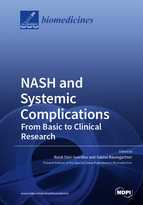NASH and Systemic Complications: From Basic to Clinical Research
A special issue of Biomedicines (ISSN 2227-9059). This special issue belongs to the section "Molecular and Translational Medicine".
Deadline for manuscript submissions: closed (31 January 2021) | Viewed by 59460
Special Issue Editors
Interests: translational research related to inflammation and metabolic health
Special Issues, Collections and Topics in MDPI journals
Interests: nutrition; NASH; lipid metabolism
Special Issues, Collections and Topics in MDPI journals
Special Issue Information
Dear colleagues,
To date, our sedentary lifestyle in combination with Western-type diets—i.e., a high intake of sugar- and fat-enriched meals—has led to an increased incidence of non-alcoholic fatty liver disease (NAFLD), both in adults and in children. NAFLD is known as the hepatic manifestation of the metabolic syndrome that encompasses a spectrum of liver diseases. Whereas most patients simply develop a fatty liver (steatosis), up to one-third are affected by nonalcoholic steatohepatitis (NASH). NASH is a chronic inflammatory condition of the liver that can further progress to fibrosis and cirrhosis, which may eventually lead to liver failure and death. Hence, NASH is considered an ongoing, global health threat. Currently, the gold standard for diagnosing NASH is a liver biopsy, which has several limitations, and therapeutic options to cure NASH do not yet exist. Therefore, there is an urgent need for a better understanding of the underlying pathophysiology of NASH.
This Special Issue supports new insights into basic and clinical research on NASH and its systemic complications. It will shed light on the pathophysiology, clinical problems, diagnostic methods, therapeutic approaches and lifestyle adaptations of NASH as well as on its systemic effects, including gastrointestinal, cardiovascular and neurological diseases, diabetes and cancer-related metabolic diseases. The overall aim of this Special Issue is to create awareness of the opportunities and challenges in translational NASH research, i.e., to explore possible answers that basic research can provide, and vice versa, to translate basic research questions to human situations. This Special Issue stimulates all junior and senior researchers and clinicians in the field of NAFLD/NASH, obesity, diabetes, cardiometabolics and cancer to share their novel findings and new ideas. Hence, our mission is to learn to understand the difficulties in finding those patients at risk of developing complicated NASH.
Prof. Dr. Ronit Shiri-Sverdlov
Dr. Yvonne Oligschläger
Guest Editors
Manuscript Submission Information
Manuscripts should be submitted online at www.mdpi.com by registering and logging in to this website. Once you are registered, click here to go to the submission form. Manuscripts can be submitted until the deadline. All submissions that pass pre-check are peer-reviewed. Accepted papers will be published continuously in the journal (as soon as accepted) and will be listed together on the special issue website. Research articles, review articles as well as short communications are invited. For planned papers, a title and short abstract (about 100 words) can be sent to the Editorial Office for announcement on this website.
Submitted manuscripts should not have been published previously, nor be under consideration for publication elsewhere (except conference proceedings papers). All manuscripts are thoroughly refereed through a single-blind peer-review process. A guide for authors and other relevant information for submission of manuscripts is available on the Instructions for Authors page. Biomedicines is an international peer-reviewed open access monthly journal published by MDPI.
Please visit the Instructions for Authors page before submitting a manuscript. The Article Processing Charge (APC) for publication in this open access journal is 2600 CHF (Swiss Francs). Submitted papers should be well formatted and use good English. Authors may use MDPI's English editing service prior to publication or during author revisions.
Keywords
- hepatic inflammation
- lipid metabolism
- overweight
- obesity
- metabolic syndrome
- systemic complications
Related Special Issue
- NASH as an Inducer of Hepatocellular Carcinoma (HCC) in Biomedicines (5 articles)







